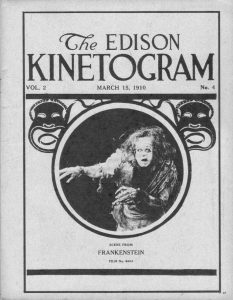This is a guest post by Mike Mashon, head of the Moving Image Section of the Motion Picture, Broadcasting and Recorded Sound Division. He writes about the first of many films based on Mary Shelley’s novel “Frankenstein,” published 200 years ago this year. The post is republished from the division’s blog, “Now See Hear!”
A scene from “Frankenstein,” published on the cover of the March 15, 1910, issue of the Edison Kinetogram.
Rarely has the arrival of a film at the Library’s Packard Campus for Audio Visual Conservation occasioned as much anticipation as the day in April 2015 when we accessed into our collection the sole surviving nitrate print of the first cinematic adaptation of “Frankenstein.” It’s not because the film, produced in 1910 by the Edison Manufacturing Company, is all that revelatory—it’s most decidedly not—or because it’s especially rare, as a quick search on YouTube will attest. Rather, this is an instance in which the story of how a particular reel came to be in our collection is more interesting than the film itself.
As an acquisitions officer, I work a lot with collectors and have a great deal of respect for them. If it weren’t for collectors, huge chunks of film history would have vanished forever; in many ways, our Silent Film Project is a testament to them. But, sometimes, I have to explain to eager sellers that there’s a difference between rarity and value; just because there’s only one print of a particular film doesn’t mean the print has much monetary value if there’s no market for it.
The nitrate print of “Frankenstein” does, however, have market value, based not only on rarity, since it truly does seem to be the single extant print, but also crucially on the cultural durability of Mary Shelley’s 1818 creation, whose bicentennial we celebrate this year.
The print also comes with a bit of notoriety because of its previous owner: Alois F. “Al” Dettlaff of Cudahy, Wisconsin. He acquired the print as part of a larger collection in the 1950s, but he wasn’t aware of the film’s significance until the American Film Institute included “Frankenstein” on a list of “top 10 most wanted lost films” in 1980.
I never met Dettlaff, but it seems like everyone in film collecting circles has a story. Often they’re about the “Father Time” character he enjoyed portraying at film conventions, compete with robe, scythe and hourglass to complement his long white beard.
He was exceptionally protective of the “Frankenstein” print, traveling with it to film festivals and monster conventions. He even took it to the Academy of Motion Picture Arts and Sciences in 1986, where academy president and famed director Robert Wise was unable to convince him to let the reel be properly preserved and archived. Eventually, Dettlaff had the film transferred to DVDs he would sell at his appearances, and it’s rips from that DVD you can find on YouTube. Dettlaff died at home in 2005 surrounded by his film collection, including “Frankenstein,” still unpreserved.
Until now, that is.
The Library purchased the Dettlaff Collection in 2014. It is full of titles we are delighted to add to our holdings, but we were especially interested to see “Frankenstein,” joking that perhaps it might arrive from Wisconsin on a bed of spun gold.
While it came in a fairly nondescript can, it didn’t take us long to get the reel into our film preservation lab for a 2K scan in advance of photochemical preservation. From that 2K scan, we worked on a digital restoration. The film’s head credits and the first intertitle were missing, but fortunately the Edison Historic Site in East Orange, New Jersey, had a copy of the head credit we could drop into place; the intertitle was recreated using the style of the other titles. We asked Donald Sosin, a highly regarded silent film composer and accompanist, to provide a score.
The newly restored version of the 1910 “Frankenstein” is also available on the Library’s YouTube channel and in the National Screening Room, our recently launched digital collection of films. And, like most films in the screening room, it’s freely downloadable in both ProRes LT and MPEG-4 formats, complete with the Sosin score.
Not long after creating the monster, Victor Frankenstein was consumed with regrets, exclaiming that he “had desired it with an ardor that far exceeded moderation; but now that I had finished, the beauty of the dream vanished, and breathless horror and disgust filled my heart.”
In our case, however, reanimating this notorious bit of cinema history was, and remains, a delight.
{mediaObjectId:'786ECF3082A10060E0538C93F1160060',playerSize:'mediumStandard'}Click Here to Read More















